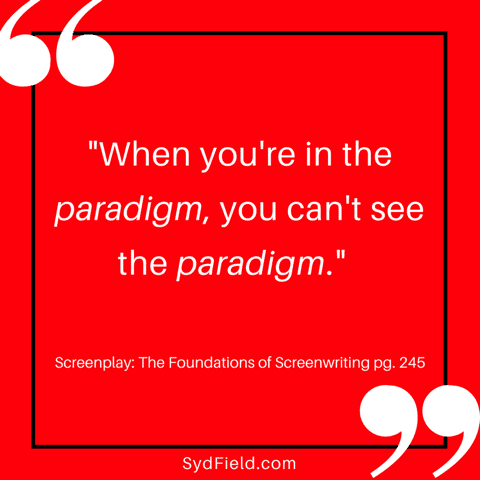SEEING THE PARADIGM
Recently, I swapped screenplays with a friend of mine. We planned to exchange notes on our early drafts and lend our respective critical eyes to each other’s work. Her script was good: a unique premise, filled with solid laughs and so much heart the Tin Man from Oz would be jealous. But her story wasn’t working. And now I was entrusted with the task of helping her figure out why.
I read the draft one more time, then sat down to compose my thoughts. I sent a long and complicated email, filled with references to page numbers, plot points, character development and conflict. My friend responded with gratitude and this universal statement:
“It’s amazing how blind we can be to our own work.”
And that, dear writer, is the struggle.
We’re crafting and creating without noticing that we have these blind spots.
Sometimes they’re tiny, but sometimes they shock us by being so large a massive truck could turn around twice without any trouble.
Experience eventually helps us recognize and avoid the onset of trouble, but each new project brings with it innate imperfections that, despite our best efforts, we simply cannot see.
Is there anything we can bring to our writing process that will alleviate or – please, oh please – eliminate our perpetual suffering over the perfect world we’ve gone and created?
Why, yes. Yes, indeed.
Syd Field knew these particular writing struggles well. He wrote about them in Screenplay: The Foundations of Screenwriting. This is the book that originated the concept of the paradigm, Field’s simple yet elegant blueprint for the structure of your screen story.
In Chapter 10 “Writing the Screenplay” Syd tells us that, “When you’re in the paradigm, you can’t see the paradigm.”
This concept helps explain all those blind spots in our writing, those story troubles that intellectually we should be able to see but, alas, we cannot. During the entirety of the writing process, we find ourselves operating in two worlds: the logical world of outlines, plot points and character arcs and the more ephemeral world of the writing itself, where our right brained creative mind runs the show. We can be totally derailed at any point during the actual writing of scenes by even the most nuanced nudge from the left brained critic inside of us.
We have to live inside our work as we create it, but then view the work from outside in order to improve it. This ever shifting point-of-view is essential for a writer during the rewriting process, when we aspire to flow from one state to the other with an easy and instant grace. Yet it really is impossible for us to live like Schrodinger’s cat, perpetually existing in two states simultaneously. That’s a recipe for never finding yourself at that final scene and blissfully typing, “The End.”
So, we must accept a certain reality about our blind spots. When we are in the magical space where imagination collides with reality, we are unable to access the part of our brain containing the sum total of screenwriting advice. Even though it’s inside our heads, we can’t always use it to our advantage.
We might spend time workshopping early drafts in writer’s groups or reaching out to trusted colleagues for feedback. Bring in a set of impartial eyes and they can spot our faults in an instant. We rage or lament, “Why? Why am I like this? Why do flaws and imperfections seem to happen to me every single time?”
Never fear. All hope is not lost.
While you’re in the first draft, write like you’re speeding along on a superhighway with no speed limit, chasing the sun. Get the words out of your brain and onto paper (or, more likely, into your computer). Don’t even consider what could be going wrong while you are in this mode. Worry is not your friend here. Your left-brained editor needs to be abandoned at a roadside rest stop for your writing to flow.
But when you run out of scenes at the end of the draft it’s time to remind yourself that when you’re in the paradigm, doing the work of the story, you can’t see the structure. It exists outside of your story, so you have to turn your head and use your brain to check if your story is working.
This is the beauty of the rewriting process, continuing to hone your screenplay until the visions in your head match the words on your pages or at least get mighty close. The knowledge you need is already inside you (and if it isn’t, begin by reading or re-reading Screenplay: The Foundations of Screenwriting).
In this classic text, Syd Field reassures us, “If you created the problem, you’ll be able to find a solution to it. All you have to do is look for it.” So true. Just recognize that you can’t do both at the same time, and you’ll be fine.


Comments are closed.